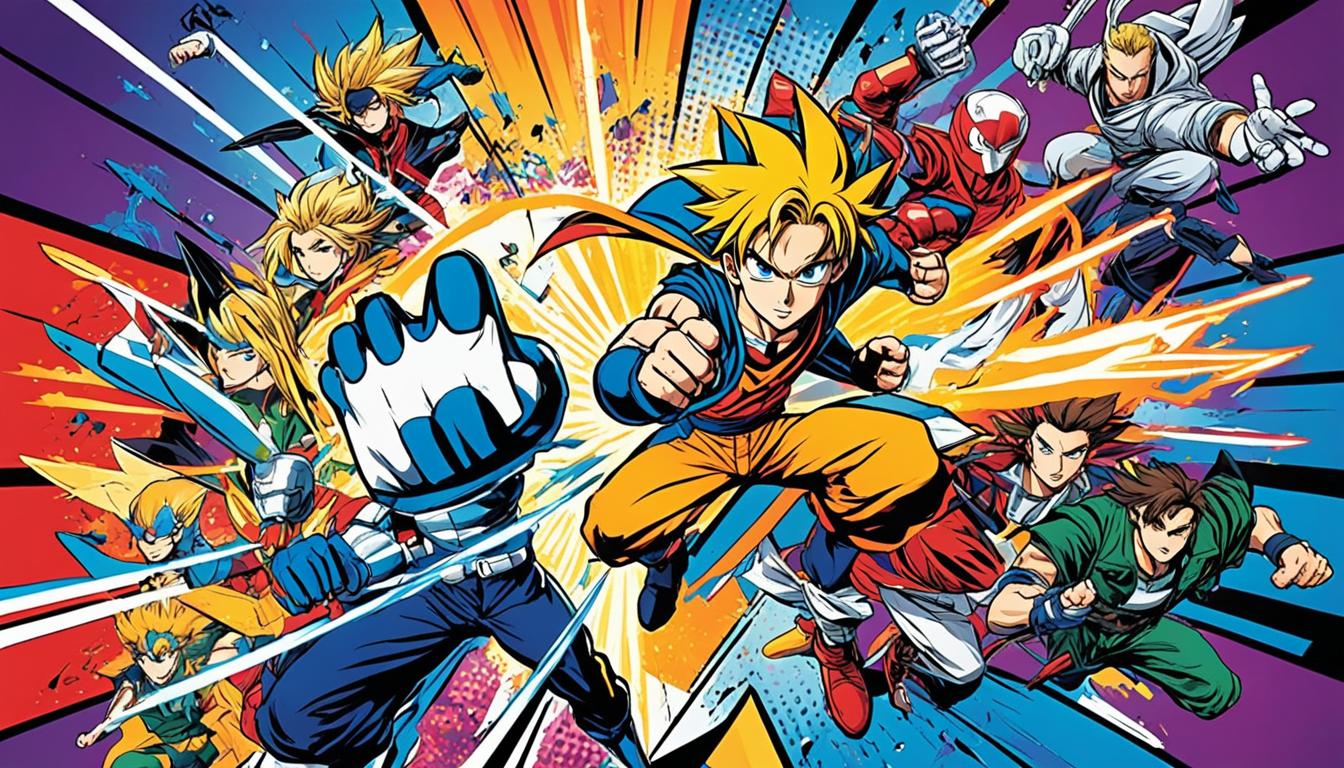The word “manga” comes from the Japanese language. It’s made of two kanji, or characters. “Man” stands for “whimsical or impromptu,” and “ga” means “pictures.” This fact shows how engaging and dynamic Japanese comics and cartoons are. For many years, anime and manga have amazed people around the world. They have sparked new ideas, connected different cultures, and made us love Japan’s traditional ways.
Beginning with Osamu Tezuka’s works in 1951, like “Astro Boy,” these creations have only grown in popularity. Characters such as Naruto and Goku are loved by many. Anime and manga are now more than just stories and drawings. They are a big part of global culture. They are known for their amazing art, interesting stories, and deep links to Japan’s culture.
Key Takeaways
- Anime and manga have transcended their Japanese origins to become globally recognized art forms.
- These media franchises captivate audiences with their visually striking and narratively compelling qualities.
- Anime and manga inspire creativity, cross-cultural exchange, and a deeper appreciation for Japanese traditions.
- Iconic characters like Astro Boy, Naruto, and Goku have become sources of inspiration, shaping global pop culture.
- The rich history and cultural influences of anime and manga contribute to their widespread appeal and impact.
Anime and Manga: Captivating Global Pop Culture
Anime’s Vibrant Visuals and Compelling Stories
Anime stands out with vibrant colors and rich backgrounds. It uses creative visuals to tell compelling stories. This unique style shows the skill and imagination of its creators.
The way anime tells stories draws you in. Its use of cinematic techniques brings emotions to life. Viewers are taken to amazing and creative worlds through anime.
Manga’s Fusion of Art and Storytelling
Manga is anime’s comic book form. It mixes art and stories to create deep feelings. Artists use special panel designs and stories that touch people all over the world.
This makes manga a captivating and loved part of global pop culture. It influences art, fashion, and creativity widely. Manga uses its art and stories to connect with people everywhere.
Tracing the Origins of Anime and Manga
Anime and manga started in Japan, rich in art. Early creators like Ōten Shimokawa began making Japanese animation in the 20th century. They added unique art styles to their work. Then came Osamu Tezuka. His manga “Astro Boy” was a hit. His style and stories still influence manga today.
Manga’s Roots in Traditional Japanese Art
Japan’s ancient art is where manga began. The art of illustrated scrolls and ukiyo-e woodblock prints showed stories in pictures. These early forms of visual expression inspired modern manga. They used pictures to tell stories in a way that’s loved worldwide.
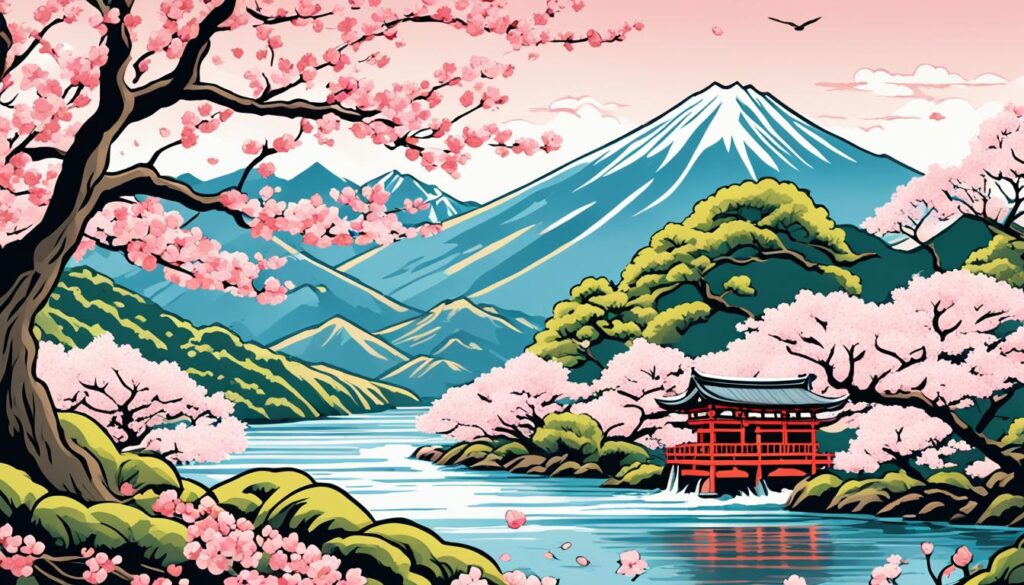
Iconic Characters that Inspire Generations
Anime and manga have brought us many iconic characters. They have captured the hearts of people around the world. These characters are now a big part of pop culture and have inspired fans everywhere.
Astro Boy: The Pioneer of Anime
Astro Boy was the creation of Osamu Tezuka, known as the father of anime. He brought themes of justice and equality for all to the forefront. Astro Boy’s stories are still loved today, showing the power of early anime to connect with people worldwide.
Naruto Uzumaki: The Determined Ninja
Naruto Uzumaki, from the manga and anime “Naruto,” is a standout hero. His look, characterized by his orange jumpsuit and ninja headband, is instantly recognizable. But it’s his never-give-up attitude that really connected with fans, making him a celebrated character who broke out of his comic origins.
Goku: The Legendary Saiyan Warrior
Goku, from “Dragon Ball,” is synonymous with legendary anime heroes. He’s known for always seeking to improve, his sense of adventure, and his many transformations. His story, filled with his quests and the tale of the Saiyan people, has captivated generations of fans.
Sailor Moon, Light Yagami, and others have also made a lasting impact on pop culture. They’ve inspired conversations across different cultures. Their stories show how beloved anime and manga characters can be for people everywhere.
The Artistry of Anime Production
The making of anime joins together many talents. This includes drawing, tech skills, and great stories. Character design is key, shown when creators shape characters to represent the story well. They think about traits such as who they are, what they do, and their background.
Character Design and Visual Storytelling
Storyboarding maps out what each scene will look like. It includes which camera view works best and how fast scenes should go. This part is vital as it is the groundwork for the animation process. Animators make characters and scenes move. They use their knowledge of the body, how things move, and feelings. This is how they turn a storyline into a vibrant present
Storyboarding and Animating Captivating Scenes
Background artists create beautiful and detailed worlds. These settings make the story’s feeling stronger. Colorists and effects artists add the final touches. They make sure everything looks well together. This group effort shows the true art and skill behind anime production. It’s what helps anime win over people from all over the world.
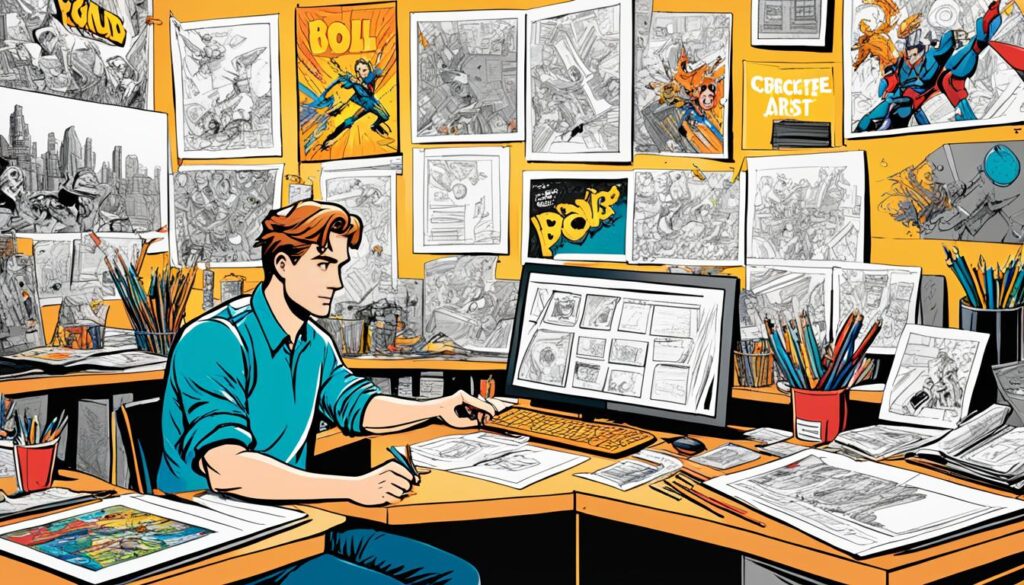
Manga’s Unique Visual Language
In manga, every page is well thought out and planned. Artists carefully decide on the layout. This helps them control how the story moves. Before finalizing each drawing, they use penciling and inking. This step makes the pictures clearer and adds depth. Characters show a lot through their faces and actions.
Penciling and Inking Techniques
The setup of panels and the space between them keep the story’s tempo. It’s like a guide for readers. Manga artists have their unique way of drawing, just like any other artist. Over time, these styles become famous in the manga world. The art and story together make a big impact.
Panel Layouts and Narrative Pacing
is an art in itself. Skilled artists use penciling and inking to lead us through strange, beautiful worlds. It’s an emotional journey for the readers.
| Manga Visual Morphemes | Meaning | Example Manga Series |
|---|---|---|
| Vein anger, bloody nose | Anger, frustration | Soul Eater |
| Drool, dread lines | Embarrassment, confusion | Dengeki Daisy |
| Blush, sweat drops | Romantic feelings, anxiety | One Piece |
| Spiral eyes, heart eyes | Surprise, love | Naruto |
Numbers and facts help understand how artists express emotions in manga. This analytical approach shows the deep thinking behind each symbol and scene.
Inspiration from Japanese Culture and Traditions
Anime and manga greatly reflect Japanese culture and traditions. They show festivals, holidays, and daily rituals in detail. Japanese clothes, buildings, and food are all presented accurately. This helps people around the world see and understand Japan’s daily life better.
These shows and comics make Japanese traditions more accessible. They inspire a love for Japan’s rich cultural background among many. This mix of cultural elements in fun stories and stunning art is why so many people love anime and manga today. It helps spread cross-cultural exchange, too.
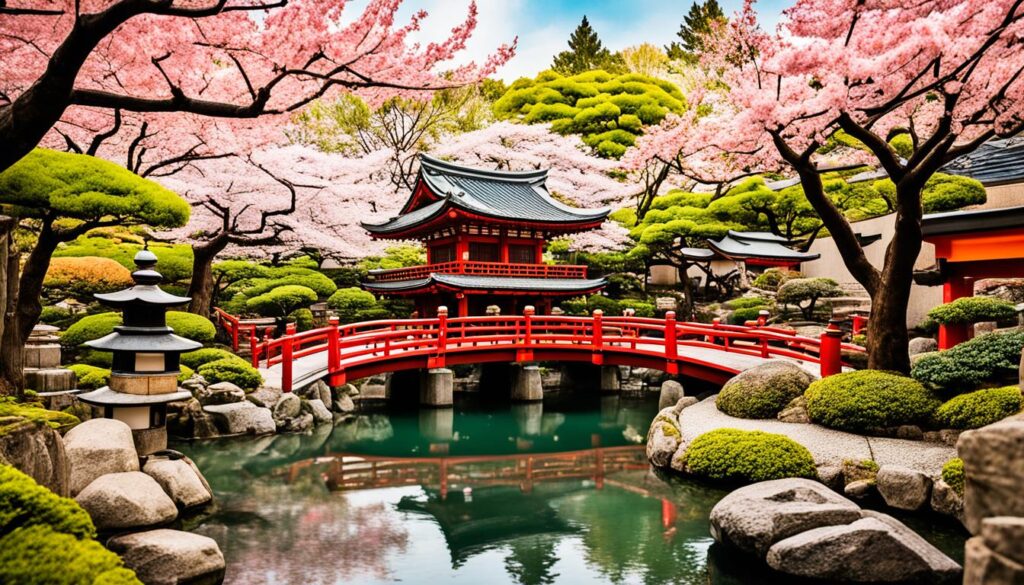
| Key Statistic | Relevance to Japanese Culture and Traditions |
|---|---|
| Kaizen is a core principle in Japan, promoting continuous improvement across businesses. | This principle of Japanese culture emphasizes attention to detail and commitment to quality in craftsmanship, which is often reflected in anime and manga. |
| Japan’s long-term perspective guides the integration of innovation with tradition seamlessly. | The ability to blend tradition and innovation is a hallmark of Japanese culture, and it is evident in the way anime and manga incorporate both elements. |
| Collaboration is crucial in Japan, supporting the thriving of tradition and innovation together. | The collaborative nature of Japanese culture is reflected in the way anime and manga creators work together to bring their visions to life, integrating tradition and innovation. |
| Japan showcases adaptability, transitioning smoothly from ancient practices to modern technologies. | This adaptability and seamless integration of tradition and modernity in Japanese culture is often mirrored in the narratives and visual styles of anime and manga. |
The influence of Japanese culture within anime and manga is huge. It really helps these forms of media connect with a worldwide audience. By showcasing Japan’s daily life and traditions, these works inspire a real love for Japanese cultural influences.
Global Impact and Cross-Cultural Exchange
Anime and manga have become a worldwide phenomenon, starting from Japan. Well-known series such as “Dragon Ball,” “Sailor Moon,” and “Naruto” have proven their ability to touch the hearts of people of various cultures. They have become essential in the global pop culture scene.
Anime and Manga’s Worldwide Popularity
These forms of media do much more than entertain. They help people around the world learn about Japan’s culture, traditions, and perspectives. In this way, they contribute to a better understanding between Japan and other countries. The fanbase shows the deep impact and importance of these forms of art on the world’s creative scene.
Fostering Cultural Understanding
The success of anime and manga has shown the world many things about Japan. People learn about its celebrations, its clothing, and its architecture through these stories. This learning sparks a real interest in Japan, helping to create more intercultural dialogues. The popularity of these forms shows their ability to connect people worldwide, united by the love of stories and art.
The Evolution of Anime and Manga
Anime and manga started as small projects but soon grew into big franchises. Thanks to trailblazers like Osamu Tezuka, they spread worldwide. They changed from simple beginnings to the huge multimedia we see today.
From Early Beginnings to Multimedia Franchises
From their start, anime and manga found fans worldwide. Now, their world includes much more than just shows and books. They have video games, movies, and lots of merchandise. This growth has brought these forms of art to so many new people. It shows how powerful and global they’ve become.
Diverse Genres and Audiences
Anime and manga now cover many genres and can be for any age. They show how versatile they can be, reaching out to all kinds of people. This ongoing change keeps them exciting and beloved by fans all over the globe.
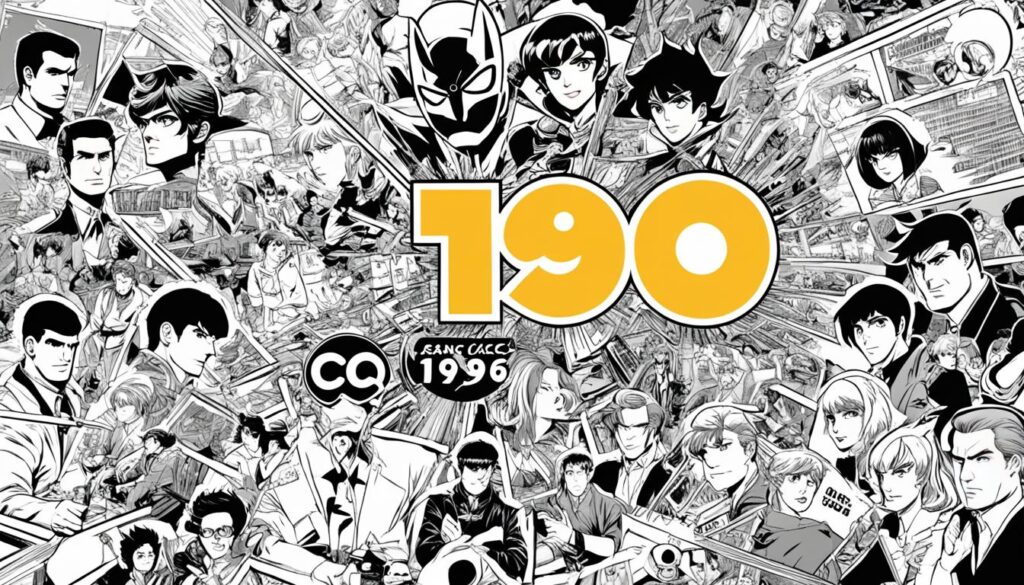
Acclaimed Creators and Their Inspiring Works
Anime and manga have brought us many amazing creators. They have inspired both artists and fans for years. One of these top creators is Hayao Miyazaki. He is the co-founder of Studio Ghibli. His films are famous for their stunning visuals and deep stories, making viewers feel like they’re in magical worlds.
Hayao Miyazaki’s Magical Worlds
Spirited Away and My Neighbor Totoro stand as some of Miyazaki’s best works. They have charmed people of all ages. His films are a mix of beautiful animation and themes that touch the heart. They mix Japanese culture with universal stories, creating movies that leave a lasting impression.
Naoki Urasawa’s Innovative Storytelling
Naoki Urasawa is another widely respected manga artist. He’s known for his big works such as Monster and 20th Century Boys. These works have made him a leading figure in the manga world. Urasawa doesn’t stick to a single genre. He mixes realistic stories with elements of science fiction and fantasy. This unique blend has won him fans all over the world.
Creators like Miyazaki and Urasawa have truly made their mark in anime and manga. Their works continue to inspire people globally. They have changed their art forms, leading the way for new generations of creators and fans.
Inspiration for Artistic Expression
Anime and manga greatly impact many forms of art worldwide. They inspire artists, fashion designers, and creatives everywhere. Through its unique visuals, designs, and storytelling, these media types spread to illustrations, paintings, sculptures, and fashion. Nowadays, we often see their influence in art, clothes, and accessories all over the world.
Anime and Manga’s Influence on Art and Fashion
The amazing images and stories in anime and manga have not only enthralled fans but also inspired many creators. The bright colors, unique characters, and exciting stories affect how artists and fashion designers do their work. Illustrators and sculptors often blend these elements into their creations. Fashion designers pick up inspiration too. They create outfits and accessories that reflect the unique look of anime and manga characters. This mixing of art and fashion has made anime and manga’s reach larger. It is loved by many people globally, proving these forms of art make a big and lasting impact.
Inspiring Creativity and Imagination
Anime and manga feed the imagination and are key to enhancing creativity. Their worlds, stories, and characters transport people to unlimited dreamscapes. This quality helps in starting creative projects. They encourage the enjoyment and exploration of visual storytelling. This in turn gives life to new ideas and art forms.
People, whether already in the art field or just starting out, find colossal inspiration in anime and manga. This has led to a lively global group of artists, illustrators, and innovators. They are constantly evolving the world of creative expression. Thanks to anime and manga, a community focused on pushing the limits of art and design has flourished.
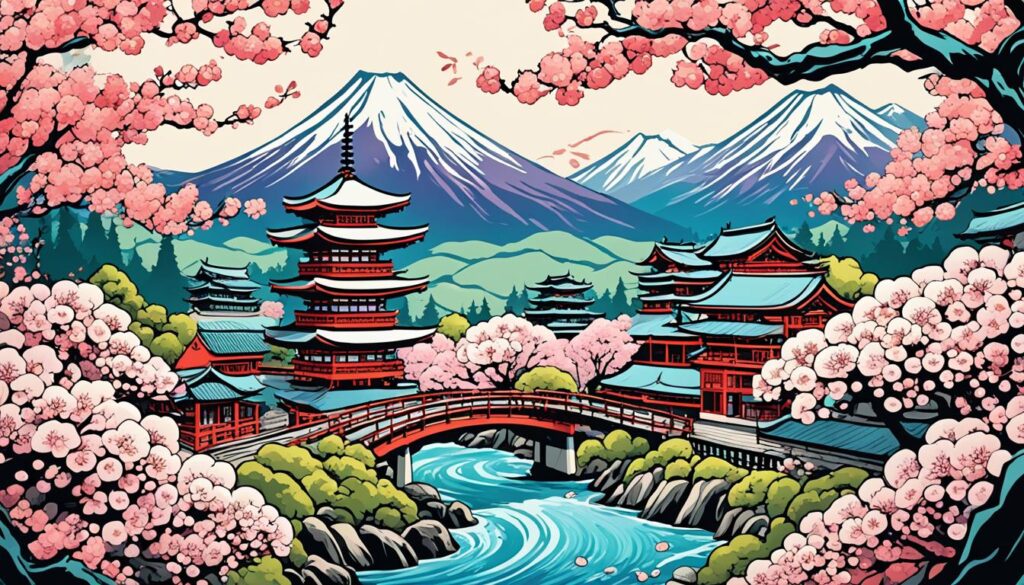
The Essence of Manga and Anime
In defining the essence of manga and anime, let’s turn to Osamu Tezuka. He’s the “godfather” of these art forms. He said manga is about “virtual,” “sentiment,” “resistance,” “bizarre,” and “pathos”.
This shows the range of feelings, stories, and art in manga and anime.
Tezuka’s words show manga and anime are more than just a show. They tell deep stories, bridge cultures, and push art to new heights. The essence of manga and anime captivates and challenges us. They break the rules of old art and media.
Exploring the World of Anime and Manga
Are you curious about anime and manga? You’re in for a treat. There’s a bunch of great stuff out there. Titles like “Astro Boy” by Osamu Tezuka started it all. Then there’s the big ones like “Dragon Ball,” “Sailor Moon,” and “Naruto.”
Recommended Series and Resources
Don’t miss the works of Hayao Miyazaki and Naoki Urasawa. They have brought us some amazing stuff. You can start your journey with manga anthologies. There are also many series available on streaming platforms.
This will help you see the wide range of genres and styles. Plus, it will show you why anime and manga are so important. They truly stand out in the world of art and storytelling.
Bridging Cultures through Anime and Manga
Anime and manga are key in joining cultures and encouraging cross-cultural sharing. They introduce people worldwide to anime culture and manga culture. This helps us understand and love Japan’s deep history. The love for anime and manga lets everyone dive into Japanese culture, from its fun festivals to classic clothes and buildings. This deep dive adds life to the stories. It also sparks a real curiosity about Japan, leading to more cross-cultural exchange and cultural understanding.
These creations have a large fanbase globally. They also mix into many artistic and cultural things. This mix shows the special strength of anime and manga. They reach past borders and bring people together. It’s all about the joy of great stories and beautiful art.
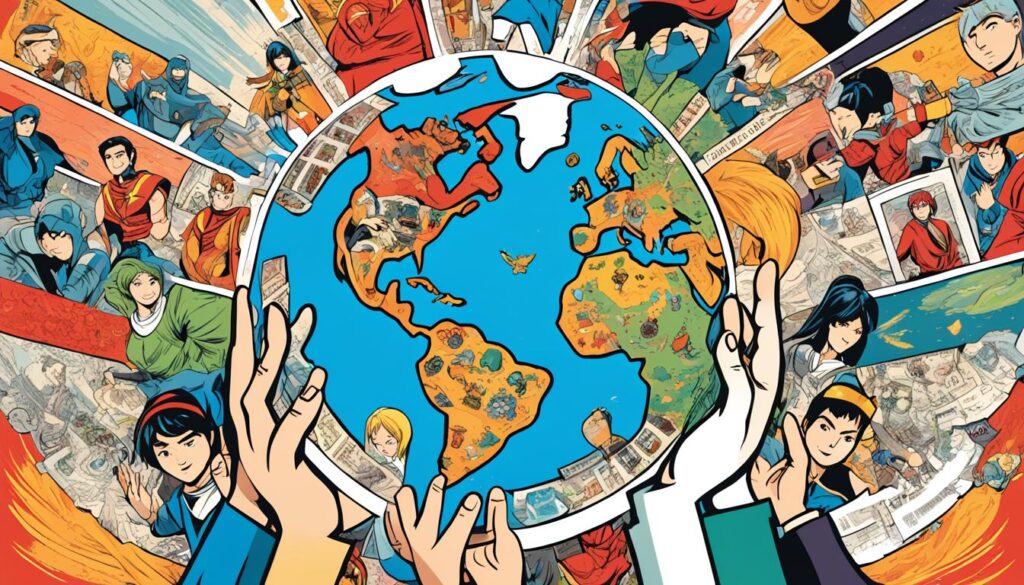
Conclusion
Anime and manga are now a big part of our world, captivating people everywhere. They stand out with their colorful art and engaging stories. They also bring a taste of Japanese culture and traditions.
They have made their way into pop culture globally. The characters, stories, and art of anime and manga have a big impact. They spark creativity, introduce us to different cultures, and deepen our love for Japanese art.
Anime and manga keep changing, but their power to connect people from all over is strong. They are more than just art forms; they create bridges between cultures. Their stories and art bring us all together into a shared world of imagination.
What makes anime and manga special is their ability to touch us, push us to think, and draw us into their worlds. They open doors for us to understand and value Japan’s culture. And they help people from different places talk and share their stories.
As more and more people join the anime and manga world, their influence grows. They will keep inspiring new creators and fans for many years to come.
FAQ
What are the key factors that have contributed to the global recognition of anime and manga as art forms?
Anime and manga are loved across the world for their amazing visuals and great stories. They introduce people to Japanese culture and inspire creativity globally. These art forms connect people through shared stories and loved characters.
What are the distinctive visual characteristics of anime and how do they captivate audiences globally?
Anime’s bright colors, detailed scenes, and unique visuals grab people’s attention. Its use of emotions and powerful scenes draws in viewers everywhere. This style has made anime a hit worldwide.
How do the visual art and storytelling techniques of manga contribute to its global appeal?
Manga weaves drawings and tales to make readers feel deeply. With creative artwork and smart story pacing, it hooks readers from all around. These skills draw in a wide, global audience.
What are the origins of anime and manga, and how have they been influenced by Japan’s rich artistic traditions?
Japanese art and storytelling traditions deeply influenced anime and manga’s start. This includes early animation, scrolls, and woodblock prints. These traditions shaped the look and feel of these popular media today.
What are some of the iconic characters that have captivated global audiences and become deeply embedded in pop culture?
Characters like Astro Boy, Naruto, and Goku are known worldwide. They spark talk between different cultures and ages. These beloved figures are key parts of pop culture, over generations.
What is the creative process involved in the production of anime and how does it contribute to the medium’s artistic depth?
Anime’s making needs many talents and technical skills. Making characters, scenes, and animations takes lots of work. This process creates the detailed and engaging shows we love.
What are the unique artistic elements and techniques that define the art of manga?
Manga has unique creativeness. Artists plan each page carefully. Their work shows feelings through characters and scenes, making each artist’s style special. Over time, their styles become well-known in the media world.
How do anime and manga incorporate elements of Japanese culture and traditions, and how does this contribute to their global appeal?
Anime and manga often show Japan’s celebrations and daily life. Adding these cultural bits in their stories and art makes them more interesting to people worldwide. It’s a big reason they’re loved around the globe.
What is the global impact of anime and manga, and how have they facilitated cross-cultural understanding and appreciation?
Anime and manga have made a big impact globally. They have shared the beauty and depth of Japanese culture with people worldwide. This has brought fans closer to Japan, its culture, and its people.
How have anime and manga evolved over time, and what factors have contributed to their continuous growth and diversification?
Since their start, anime and manga have changed a lot, offering more genres and stories. They meet the likes of many, from kids to adults. These changes show they’re very dynamic, exciting, and influential to people all over the world.
Who are some of the acclaimed creators of anime and manga, and how have their works inspired generations of artists and audiences?
Creators like Hayao Miyazaki and Naoki Urasawa have made works that stand out. They tell rich, creative stories that impact viewers and inspire other artists. Their work is seen as top-notch in the world of anime and manga.
How have anime and manga influenced artistic expression and creativity in various art forms and disciplines?
Manga and anime have been big inspirations to artists and creators worldwide. Their unique styles, characters, and stories can be seen in art, fashion, and beyond. They’ve helped bring many forms of creative work together, pushing art and design to new heights.
How do the words of Osamu Tezuka, the “godfather” of anime and manga, capture the essence of these art forms?
Osamu Tezuka called manga “virtual,” “sentiment,” and much more. His words show how much manga and anime mean to us. They are not just for fun. They share deep stories and cultures, and they spark creativity and wonder.
What are some recommended resources and series for those interested in exploring the world of anime and manga?
There are many great titles to start with, such as works by Osamu Tezuka, and popular series like “Dragon Ball” and “Naruto.” Exploring these series opens doors to Japan’s rich creative world. It helps you understand and enjoy the influence they have had on the world of art and storytelling.
How have anime and manga played a role in bridging cultures and fostering cross-cultural exchange?
Anime and manga have been bridges between cultures, introducing Japan to the world. They’ve shown people different cultural aspects, creating interest and understanding. Their worldwide popularity unites people in appreciating Japan’s rich heritage.
Source Links
- https://www.japanhousela.com/articles/the-impact-of-manga-and-anime/
- https://different-level.com/anime-manga-or-how-japan-became-international/
- https://www.toki.tokyo/blogt/2023/8/9/anime-and-manga-exploring-a-cultural-phenomenon
- https://www.linkedin.com/pulse/anime-manga-global-influence-japanese-pop-culture-ak-japan-imports-dolcf
- http://www.e-budo.com/forum/showthread.php?25714-Manga-Anime-And-Its-Influence-On-Pop-Culture
- https://en.wikipedia.org/wiki/History_of_anime
- https://leverageedu.com/blog/fictional-characters/
- https://www.empireonline.com/movies/features/100-greatest-movie-characters/
- https://www.thegentlemansjournal.com/article/most-inspirational-people/
- https://keyframemagazine.org/2020/08/14/the-influence-of-anime/
- https://washiblog.wordpress.com/2011/01/18/anime-production-detailed-guide-to-how-anime-is-made-and-the-talent-behind-it/
- https://www.sothebys.com/en/articles/big-eyes-the-visual-language-of-manga-in-contemporary-art
- https://en.wikipedia.org/wiki/Manga_iconography
- https://www.visuallanguagelab.com/jvl
- https://www.toki.tokyo/blogt/2023/8/9/japan-the-enigmatic-dance-of-tradition-and-innovation
- https://www.vangoghmuseum.nl/en/art-and-stories/stories/inspiration-from-japan
- https://alljapantours.com/japan-attraction/traditional-culture-experiences/
- https://www.intechopen.com/chapters/38267
- https://fastercapital.com/content/Globalization–The-Impact-of-Cross-Cultural-Exchange-on-the-World.html
- https://www.franklinarts.com/blog/entry/artists-who-inspire-me
- https://www.booooooom.com/2021/05/05/27-artists-reveal-who-inspires-their-work/
- https://www.nikonusa.com/learn-and-explore/c/ideas-and-inspiration/20-creators-inspiring-us-this-year
- https://www.goshen.edu/art/ed/quest4o.htm
- https://artstoheartsproject.com/5-sources-of-creative-inspiration-for-artists/
- https://michelsabbagh.wordpress.com/2016/01/06/becoming-the-mecha/
- https://www.toonsmag.com/anime/
- https://animebanzai.org/?p=3363
- https://www.linkedin.com/pulse/introduction-manga-anime-understanding-roots-global-reach-muqadim-cf6if
- https://homearthaven.com/blogs/news/cultural-crossroads-east-meets-west-the-influence-of-manga-and-anime-on-global-art-trends
- https://blog.hubspot.com/marketing/writing-powerful-conclusions
- https://link.springer.com/chapter/10.1007/978-1-349-07509-6_8
